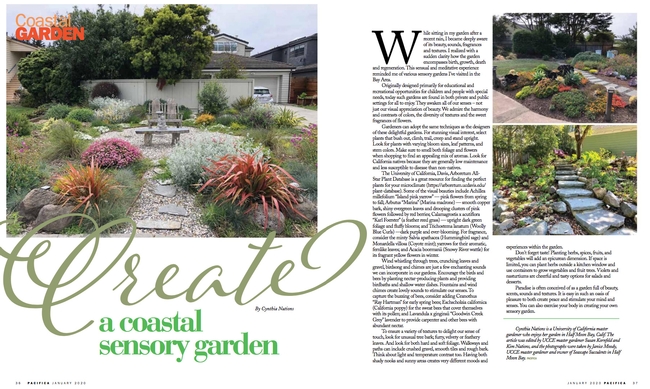While sitting in my garden after a recent rain, I became deeply aware of its beauty, sounds, fragrances, and textures. I realized with a sudden clarity how the garden encompasses birth, growth, death, and regeneration.This sensual and meditative experience reminded me of various sensory gardens I've visited in the Bay Area.
Originally designed primarily for educational and recreational opportunities for children and people with special needs, today such gardens are found in both private and public settings for all to enjoy. They awaken all of our senses – not just our visual appreciation of beauty. We admire the harmony and contrasts of colors, the diversity of textures, and the sweet fragrances of flowers.
Gardeners can adopt the same techniques as the designers of these delightful gardens. For stunning visual interest, select plants that bush out, climb, trail, creep, and stand upright. Look for plants with varying bloom sizes, leaf patterns, and stem colors. Make sure to smell both foliage and flowers when shopping to find an appealing mix of aromas. Look for California natives because they are generally low maintenance and less susceptible to disease than non-natives.
The UC Davis Arboretum All-Star Plant Database is a great resource for finding the perfect plants for your microclimate. Some of the visual beauties include Achillea millefolium ‘Island Pink yarrow'-- pink flowers from spring to fall; Arbutus ‘Marina' (Marina madrone)--smooth copper bark, shiny evergreen leaves, and drooping clusters of pink flowers followed by red berries; Calamagrostis x acutiflora ‘Karl Foerster' (a feather reed grass)--upright dark green foliage and fluffy blooms; and Trichostema lanatum (Woolly Blue Curls)--dark purple and ever-blooming. For fragrance, consider the minty Salvia apathacea (Hummingbird sage) and Monardella villosa (Coyote Mint); yarrows for their aromatic, fern-like leaves; and Acacia boormanii (Snowy River wattle) for its fragrant yellow flowers in winter.
Wind whistling through trees, crunching leaves and gravel, birdsong, and chimes are just a few enchanting sounds we can incorporate in our gardens. Encourage the birds and bees by planting nectar-producing plants and providing birdbaths and shallow water dishes. Fountains and wind chimes create lovely sounds to stimulate our senses. To capture the buzzing of bees, consider adding Ceanothus 'Ray Hartman' for early spring bees; Eschscholzia californica (California poppy) for the sweat bees who cover themselves with its pollen; and Lavandula x ginginsii ‘Goodwin Creek Grey' lavender to provide carpenter and other bees with abundant nectar.
To ensure a variety of textures to delight our sense of touch, look for unusual tree bark; furry, velvety, or feathery leaves; and both hard and soft foliage. Walkways and paths can include crushed gravel, smooth tiles, and rough bark. Think about light and temperature contrast, too: having both shady nooks and sunny areas creates very different moods and experiences within the garden.
Don't forget taste! Planting herbs, spices, fruits, and vegetables will add an epicurean dimension. If space is limited, you can plant herbs outside a kitchen window and use containers to grow vegetables and fruit trees. Violets and nasturtiums are cheerful and tasty options for salads and desserts.
Paradise is often conceived of as a garden full of beauty, scents, sounds, and textures. It is easy in such an oasis of pleasure to both create peace and stimulate your mind and senses. You can also exercise your body in creating your own sensory garden.
Cynthia Nations is a UCCE Master Gardener who enjoys her garden in Half Moon Bay, CA. The article was edited by UCCE Master Gardener, Susan Kornfeld and Kim Nations, and the photographs were taken by Janice Moody, UCCE Master Gardener and owner of Seascape Succulents in Half Moon Bay.
Attached Images:
